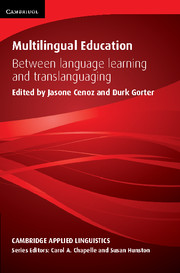Book contents
- Frontmatter
- Contents
- List of contributors
- Series editors’ preface
- Acknowledgements
- 1 Towards a holistic approach in the study of multilingual education
- 2 L1 as a pedagogical resource in building students’ L2 academic literacy: pedagogical innovation in the science classroom in a Hong Kong school
- 3 Linking content, linking students: a cross-linguistic pedagogical intervention
- 4 The role of the native language in the literacy development of Latino students in the United States
- 5 A nexus analysis of code choice during study abroad, and implications for language pedagogy
- 6 Multilingual practices in foreign language study
- 7 Language choices and ideologies in the bilingual classroom
- 8 Communicative repertoires in the community language classroom: resources for negotiating authenticity
- 9 Complementary classrooms for multilingual minority ethnic children as a translanguaging space
- 10 Constructing in-between spaces to ‘do’ bilingualism: a tale of two high schools in one city
- 11 Becoming multilingual and being multilingual: some thoughts
- Index
3 - Linking content, linking students: a cross-linguistic pedagogical intervention
Published online by Cambridge University Press: 17 September 2021
- Frontmatter
- Contents
- List of contributors
- Series editors’ preface
- Acknowledgements
- 1 Towards a holistic approach in the study of multilingual education
- 2 L1 as a pedagogical resource in building students’ L2 academic literacy: pedagogical innovation in the science classroom in a Hong Kong school
- 3 Linking content, linking students: a cross-linguistic pedagogical intervention
- 4 The role of the native language in the literacy development of Latino students in the United States
- 5 A nexus analysis of code choice during study abroad, and implications for language pedagogy
- 6 Multilingual practices in foreign language study
- 7 Language choices and ideologies in the bilingual classroom
- 8 Communicative repertoires in the community language classroom: resources for negotiating authenticity
- 9 Complementary classrooms for multilingual minority ethnic children as a translanguaging space
- 10 Constructing in-between spaces to ‘do’ bilingualism: a tale of two high schools in one city
- 11 Becoming multilingual and being multilingual: some thoughts
- Index
Summary
Towards cross-linguistic immersion pedagogy
It might sound odd to call French immersion a ‘grassroots’ bilingual programme today, but it originally represented a community's response to a local need. At a time when the French language was shifting from a position of disadvantage to a position of prestige in Quebec (d’Anglejan, 1984 ; Genesee & Gándara, 1999 ; Lamarre, 1997 ), parents in St Lambert, Quebec, mobilized to create a more intensive French L2 programme to help their children succeed in Quebec's changing linguistic environment. What emerged was a programme that was tailored to the L2 learning needs of this homogeneous group of anglophone students and that launched cutting-edge approaches to communicative language teaching.
Those cutting-edge approaches included combining content and language learning goals by instructing at least half of the curriculum through the medium of French. This approach is based on the same principle as the Direct Method of language teaching which posits that students are supposed to learn the L2 through the L2, not through the L1, and that the L1 and L2 should be kept separate in the classroom (Stern, 1992 ; Cook, 2001 ; Cummins, 2007 ). According to the Direct Method, we can learn a language best if we learn it in the same way that we learned our L1 – through exposure to that language. Further influencing this approach to language instruction within French immersion was Krashen's Input Hypothesis, which argues that passive exposure to comprehensible input is the only ‘essential ingredient’ (1985: vii) for acquiring either an L1 or an L2.
These ideas on second language education translated to a pedagogical practice in which immersion teachers did not explicitly teach language because learners were supposed to be able to absorb their L2 without focused effort (Dalton-Puffer, 2007 ). Furthermore, in order to prevent the L1 from interfering with acquisition of the L2, the French immersion model maintained strict separation of the two languages of instruction. The L1 was considered an obstacle, or at least irrelevant, to the learning of the L2 (Cook, 2001 ), and separation of languages in the classroom was intended to separate the languages in the students’ minds (Jessner, 2006 ).
- Type
- Chapter
- Information
- Multilingual EducationBetween Language Learning and Translanguaging, pp. 35 - 60Publisher: Cambridge University PressPrint publication year: 2015
- 8
- Cited by

